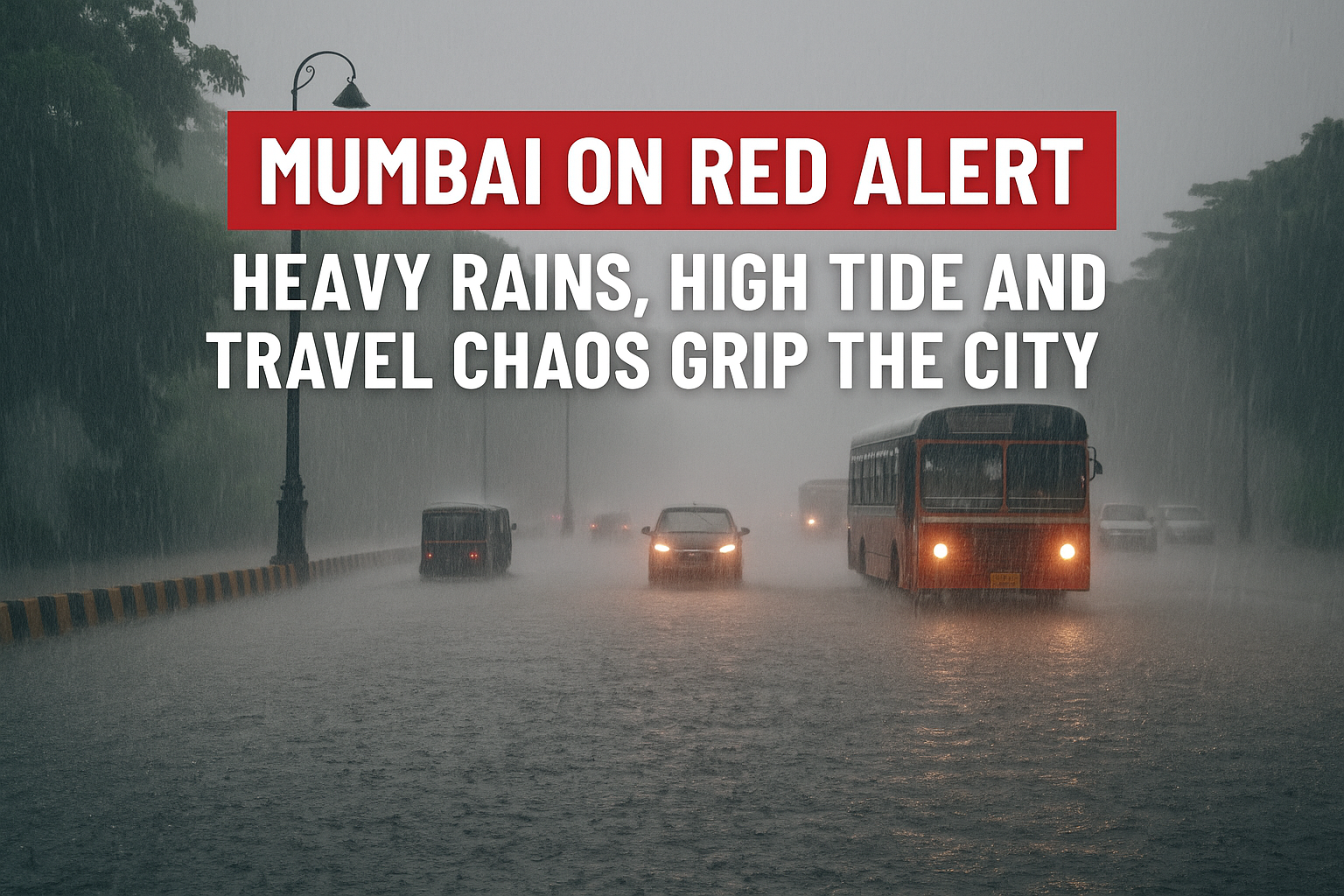
Mumbai on Red Alert: Heavy Rains, High Tide and Travel Chaos Grip the City
When it rains in Mumbai, it doesn’t just fall—it rearranges the city’s rhythm. The India Meteorological Department (IMD) has issued a severe rainfall alert, with the city placed under a red alert in Mumbai today live. For millions of citizens, this isn’t simply a weather update; it’s the difference between reaching work, missing school, or spending the night stranded at a station.
Weather Forecast: More Than Just Numbers
The Mumbai weather forecast has been dominated by predictions of heavy rains in Mumbai, accompanied by a high tide in Mumbai today. The IMD Mumbai has warned of rising sea levels and windy weather, increasing the risk of water logging in Mumbai today.
But forecasts are not just numbers—they are early warnings that decide how people, businesses, and governments respond. For a daily wage worker, the rain in Mumbai today is about lost income. For a small business, it’s about disrupted supply chains. For families, it’s about safety. That is why the today weather report and today rain updates are tracked with the same urgency as stock market indices or cricket scores.
The mumbai rains weather forecast has become less about convenience and more about survival planning. Citizens rely on live news Mumbai and news today portals to navigate their routines. The sheer dependence on weather report today alerts underscores how deeply climate patterns are intertwined with urban life.
Trains, Flights, and the Pulse of the City
Nowhere is the impact more visible than in mobility. The Mumbai local train news today reflects delays, diversions, and cancellations caused by flooded tracks. Western Railway news reports highlight how waterlogging slows down one of the busiest suburban networks in the world. Despite heroic efforts by staff, the local train news and Mumbai train news point to the same reality every monsoon—rail tracks are not just pathways but lifelines.
At the same time, Mumbai airport struggles to cope with the downpour. Delays in IndiGo flight status and overall flight status updates reflect the cascading effect of weather on aviation. When flights are grounded, schedules of businesses, families, and international connections collapse. Passengers refresh their phones for flight and train status updates almost every hour, underscoring how fragile modern logistics are to nature’s whims.
This is why today’s news headlines are filled with images of people wading through knee-deep water, stalled buses, and long queues at stations. It’s not just a city under rain; it’s a city negotiating resilience.
A Governance and Infrastructure Test
The truth is, water logging in Mumbai is no longer just about clogged drains. It is a governance question. Why does India’s financial capital—home to billion-dollar infrastructure projects—still falter every monsoon? Why does a Mumbai rainfall alert continue to trigger disruption year after year?
The IMD weather warnings are accurate, but warnings without preparedness mean little. A Mumbai red alert cannot remain just a meteorological classification—it must be a call to action. Urban planners, municipal engineers, and political leadership must treat today rain not as an annual nuisance but as a predictable stress test.
Infrastructure needs to evolve. Smarter stormwater drains, better zoning laws, and climate-resilient design are not optional—they are survival imperatives. The news Mumbai cycle may highlight the problem every year, but true governance will be measured by whether tomorrow’s mumbai rains weather headlines change.
The Systemic Lens: Beyond Mumbai
What makes the rain today story larger than the city is how it mirrors India’s urban challenge. Rapid growth, vertical housing, and strained public transport are colliding with unpredictable weather. The imd can provide forecasts, but only governance can provide resilience.
Consider this: every time a red alert in Mumbai today live is announced, lakhs of commuters alter their lives around it. Every time a flight status update flashes red, global businesses dependent on Mumbai adjust schedules. Every local train news bulletin is more than transport information; it is about productivity, dignity, and predictability in people’s lives.
Cities like Mumbai cannot afford to treat monsoons as disruptions. They must treat them as data points for better design. If imd mumbai provides a today weather report, then policymakers must convert it into drainage plans, traffic diversions, and emergency health services.
Conclusion: From Survival to Resilience
The today’s news headlines may highlight rain in Mumbai today, but the bigger headline should be about how the city adapts. Checking the weather in Mumbai today or the today weather report shouldn’t be about wondering whether you will reach home safely. It should be about knowing the system is designed to cope.
The mumbai rains weather narrative cannot remain about endurance. It must shift to resilience. When news today reflects imd weather alerts, and when flight and train status updates flood timelines, it is clear—Mumbai is not just fighting water, it is fighting the gap between growth and governance.
As the severe rainfall alert continues, the city once again proves its paradox: vulnerable yet unbroken, flooded yet moving. But survival cannot be the benchmark of a global city. The real test of Mumbai’s future lies in whether the weather report today becomes tomorrow’s blueprint for a more resilient, dignified, and livable city.





